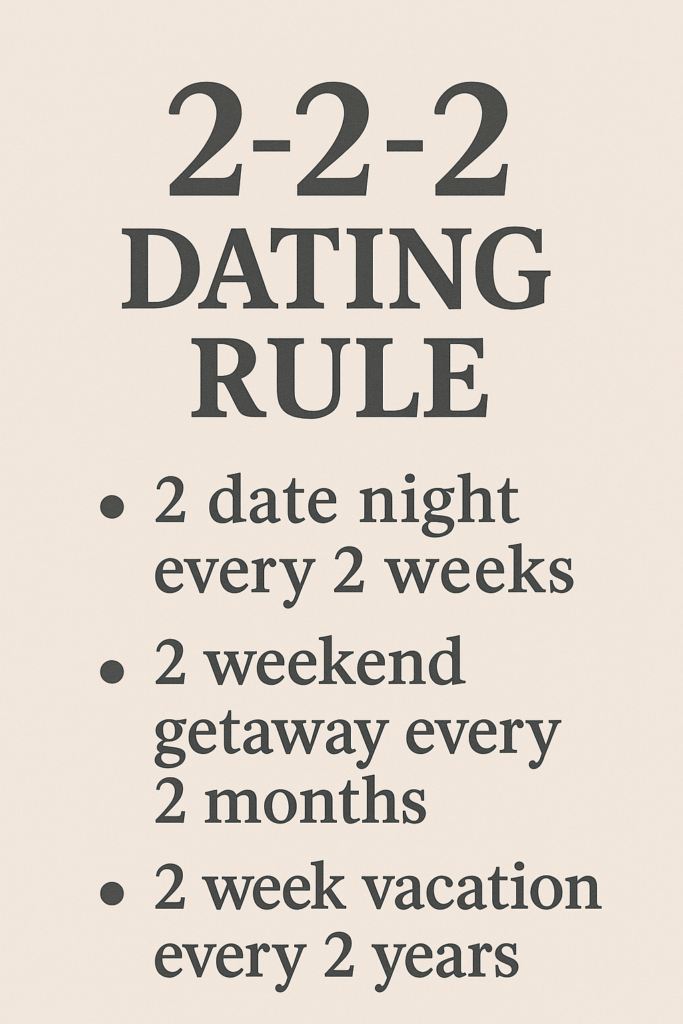
Key points
• It’s a simple formula to pace new relationships and avoid coming on too strong. Some people swear by this method to build interest to keep people from wanting more.
• The main research shows mixed results on the effectiveness of the 2-2-2 rule. Studies show that most successful couples don’t follow strict timing rules but instead focus on honest communication based on their feelings.
• The main problem with the 2-2-2 rule is that it treats dating like a game instead of a real connection between two people. The best approach is to be real about your interests while still having your own life and not rushing things too fast.
Contents
The “2-2-2 Dating Rule” has been onset on the internet for a long time and people are thinking about new relationships. This also gives an idea of how to date accordingly instead of having a freestyle one.
This 2-2-2 rule protects someone from oh-so-common “rush in and crash out” relationships that damage the vibe. The suggested action is to go slow and pay attention.
Definition and Overview

The 2-2-2 Dating Rule is pretty simple. You get someone’s number then you wait two days to text back. Then after your first date you wait another two days to follow up. You don’t sleep together until the second date at the earliest.
That’s it! It’s not about being mean or playing hard to get. It’s about giving yourself space to think clearly.
Purpose and Goals
What’s the point of this rule?
First is that love bombing is too much attention and too fast that it hides the red flags. It also allows you to take stock of your feelings. Are you really into them, or are you flattered that they are into you?
The rule creates a cushion that helps you to see clearly.
The goal isn’t to play games but to build something real. The guideline helps distinguish between a real connection and someone giving you attention; flattery versus authentic chemistry. It’s starting things on solid ground rather than on shifting sand.
The Origin of the 2-2-2 Dating Rule

According to this rule – you must wait for 2 days to text back, 2 weeks to ask for another date, and 2 months before getting serious. It’s basically numbers that help you slow down a new relationship.
This rule didn’t just pop up out of nowhere. It came from older dating “rules” like the 3-day rule to wait 3 days to call after a date.
Texting has replaced calling so people need new rules that fit how we talk now. Dr. Helen Fisher (biologist and anthropologist) says that these rules use our brain’s reward systems—creating a “thrill of the chase” waiting period that releases dopamine when there’s contact (Fisher, 2016).
Historical Context
Dating rules have been around for a long time. They want women and girls to be mysterious and play hard to get. Back in the 1950s “The Rules” told women just to do that. The 2-2-2 approach is just a modern version of this old idea of giving structure to the messy world of dating.
Before phones and apps – courtship had strict timing too. Couples in the Victorian followed elaborate codes about when to visit or send a letter.
Social Historian Stephanie Coontz said: “Throughout history, societies erected artificial barriers and waiting periods in courtship to create anticipation and test commitment.”
The 2-2-2 rule became a popular dating guideline in the 2010s because of smartphones. Dating applications made it much easier to feel the need to stop it. The rule allowed them to slow things down when relationships felt too fast.
Cultural Influences
People use dating rules because of some popular things. TV shows and movies seem to show characters that wait by the phone or fight over text timing. Have you ever noticed how often sitcom plots center around the idea of “when should I call them back?”
Different cultures view this rule differently.
Social media changed how the rule works too. When they read it; we can see that now. This adds a whole new layer of stress to dating aims to eliminate the anxiety we feel over reading messages by giving a timeline.
The rule isn’t without critics. Esther Perel states that “the timing rules that we create often become a game that prevents you from connecting. These artificial timing rules often create games that inhibit authentic connection.”
Principles of the 2-2-2 Dating Rule

The guideline serves as a map for fresh partnerships – providing obvious moments to reevaluate yourself regarding how things are advancing.
The 2-2-2 rule is about pacing. Dr. John Van Epp’s book “How to Avoid Falling in Love with a Jerk” describes it as “getting to know someone is more of a process and less of an event.”
Using this rule can help you manage your feelings while getting to know someone. It prevents you from making giant decisions based simply on those early butterflies.
Spend 2 days, 2 weeks, and 2 months
So what does this timeline look like? The 2-2-2 rule breaks down into three key periods.
- The first two days after your meeting time are your gut check. How do you feel about this person? Do they seem kind? Are there any red flags?
- The first two months of the relationship is when you get to know the person other than the “best behavior” phase. You see how they manage stress, socialize with friends, and learn their values. After two months you should see whether there is long-term potential or not.
Progression and Milestones
All of the 2-2-2 rule spans come with checkpoints that help you gauge your relationship. According to Fletcher et al. (2014) – first impressions can reflect compatibility.
By now you must be comfortable to be yourself around them. You’ve likely had some important talks and know some essential things about their life and values.
After 2 months the people will show their true form. You probably had a little spat and saw how they dealt with it. Couples therapist Dr. Gary Brown states “By two months you should have enough insight to ascertain if this relationship is worth more time and emotional investment.”
Psychological Insights

The 2-2-2 dating rule makes sense. It’s about how our mind works when falling for someone. It says you should text back after 2 days, ask for a second date after 2 weeks, and get serious after 2 months.
Studying the attachment theory can help explain this and how we connect. A study by Cindy Hazan and Phillip Shaver revealed that more than half of people (56%) have a secure attachment. While the ones who aren’t secure are likely the anxious or avoidant (Hazan & Shaver, 1987).
This guideline seems most effective for those who are avoidant or need space. But for anxious folks? Not so much. They stress when waiting for texts. It works because the distance allows both parties to think: “Do I like this person?”
Emotional Development
How we manage our emotions is a big deal to dating success. The 2-2-2 rule helps manage those early dating jitters. When you wait two days before texting back; you give your brain time to think.
Some people feel secure, not insecure, or with quick responses – and that’s okay. The 2-2-2 rule isn’t one-size-fits-all. The most important thing is knowing your type and getting someone who knows that.
Relationship Dynamics
How we act with each other makes or breaks relationships. The 2-2-2 rule tries to balance power between people. Waiting 2 days to text makes you look like you’re not coming off as needy.
Waiting 2 weeks for a second date keeps things casual. Holding off 2 months before getting serious? That gives you time to see the real person.
Research by Dr. John Gottman found that successful couples reply to each other’s needs consistently and quickly (Gottman, 2015). They don’t play waiting games.
Using the 2-2-2 rule might be useful to avoid being too intense in the early stages but it can also damage trust. It should be taken as a guide and not as a law or strict rule as every couple has their own rhythm.
Some couples can text all day while other couples need space to miss each other. The point isn’t about following rules- it’s what works for you.
Application in Modern Relationships

Take 2 days to reply, 2 weeks for the first date, 2 months before getting serious. It works best when both parties know what’s going on.
Research shows relationships can be more meaningful when your phones aren’t stuck to your feet. It explains how couples who took time to develop their relationship were more satisfied.
Challenges and Criticisms
The main problem? It treats all relationships the same as if the couple moves in the same direction with the same pacing and emotions.
Another issue? This rule feels like a game. A game that creates distance and uncertainties.
Potential Drawbacks
The biggest downside is that the rule can somewhat feel fake. Liking someone won’t make you wait two days before texting back. Making the person you like to wait for you seems wrong.
This might also make you miss good chances. What if the person you like is talking to someone else during those two days? What if the delay causes someone to walk away?
The timing feels random too. Why two days? Why two months? These numbers don’t match what happens in real relationships.
Critiques from Relationship Experts
- Our brains don’t work on set schedules when we fall for someone.
- Trust needs honest talks; not timing tricks.
- The rule ignores how we connect today.
Frequently Asked Questions (FAQ)
Does the 222 rule work for couples with kids?
The 222 rule requires adaptation for couples with children as childcare responsibilities often place relationships on the back burner. The authors suggest planning dates during school hours or scheduling regular family activities like grocery store walks to maintain a partnership spark. Ankur Warikoo points out that couples with kids must be more intentional with their calendars and use apps to coordinate childcare during their designated relationship time.
Are there financial considerations when following the 222 rule?
Financial planning forms an essential part of the 222 rule regarding the expense of regular dates and vacations in the timeframe. A CPA notes that couples should create a specific budget for their 222 activities to avoid financial strain during tight periods like tax season when paying bills takes priority. The rule doesn’t require expensive destination trips – even simple and low-cost activities count as long as partners exert effort to move away from daily chores and work responsibilities.

I am an award-winning author who has deep insights into the world of dating & relationships. I have won several awards including Andromeda Magazine – Fantasy Short Fiction Story award amongst several other awards and writing achievements.